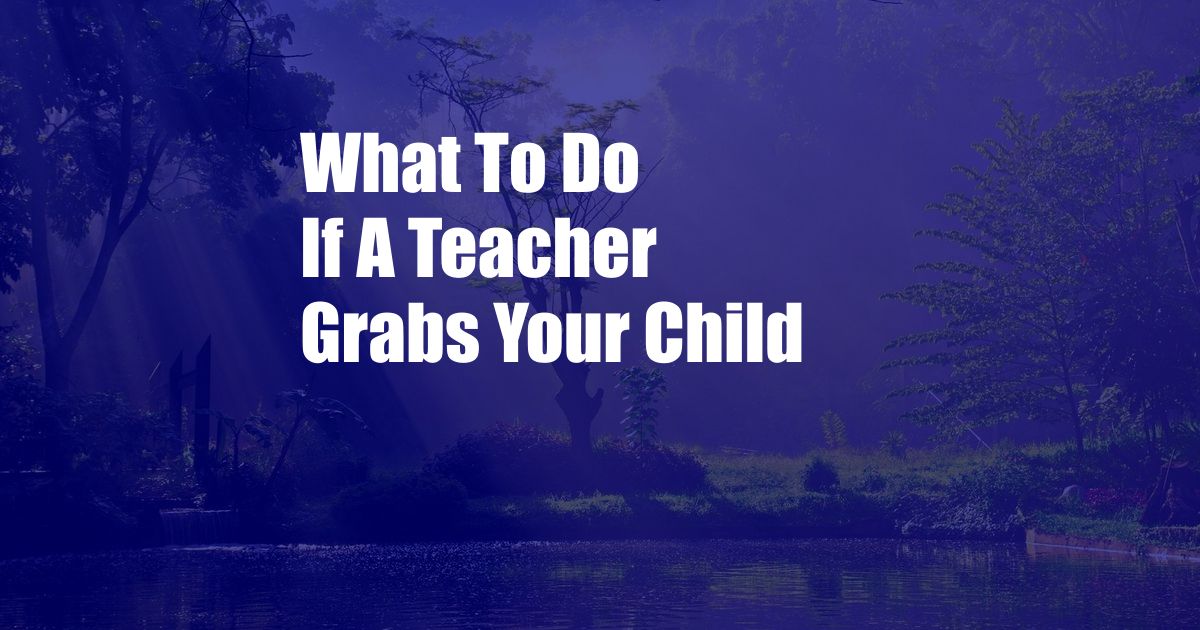
What to Do if a Teacher Grabs Your Child
As a parent, your child’s well-being is your utmost priority. The thought of them being harmed or mistreated by someone in a position of trust, such as a teacher, can be terrifying. If you ever find yourself in this situation, it’s crucial to act quickly and wisely to protect your child and ensure their safety.
Unfortunately, incidents of teachers physically handling students occur more frequently than we’d like to believe. While some may be unintentional or for disciplinary purposes, others may cross the line into abuse. It’s essential to understand the definitions and boundaries to respond appropriately.
Physical Restraint vs. Physical Abuse
Physical restraint involves using minimal force to control a student’s behavior. It is often used as a last resort when other methods, such as verbal de-escalation or positive reinforcement, have failed. Physical abuse, on the other hand, is any intentional act that causes harm or injury to a child.
When a teacher physically restrains a child, it should always be done in a safe and appropriate manner. The force used must be proportionate to the situation and should never cause pain, injury, or humiliation. If you believe your child has been physically abused by a teacher, it is crucial to take immediate action.
What to Do if a Teacher Grabs Your Child
If you witness or suspect that a teacher has inappropriately grabbed your child, follow these steps:
- Stay calm. It can be difficult to remain composed in such a situation, but it’s essential to stay level-headed to make sound decisions.
- Remove your child from the situation. Ask the teacher to stop and take your child away from the environment immediately.
- Document the incident. Write down the details of what happened, including the date, time, and any witnesses present.
- Report the incident. Inform the school principal, superintendent, and any other relevant authorities. Be prepared to provide details of the incident and any supporting evidence.
- Seek medical attention if necessary. If your child has sustained any injuries, seek medical attention as soon as possible.
Expert Advice and Tips
In addition to the above steps, here are some expert tips:
- Trust your instincts. If you feel something is wrong, don’t hesitate to speak up.
- Be objective. Try to avoid making accusations without evidence. Focus on the facts and provide specific examples.
- Seek professional advice. If you’re unsure how to proceed, consult with a lawyer or child protection agency.
Remember, the safety and well-being of your child should be your top priority. If you believe a teacher has mishandled your child, don’t hesitate to take action. By following these guidelines, you can help protect your child and ensure their rights are respected.
FAQs
Q: What should I do if I suspect my child has been abused by a teacher?
A: Report the incident to the school authorities and seek medical attention if necessary. Contact a lawyer or child protection agency for further guidance.
Q: What constitutes physical abuse?
A: Any intentional act that causes harm or injury to a child, including grabbing, shoving, or hitting.
Q: What is the difference between physical restraint and physical abuse?
A: Physical restraint is the use of minimal force to control a child’s behavior in a safe and appropriate manner. Physical abuse is any use of force that causes harm or humiliation.
Conclusion
Protecting your child from harm is a fundamental responsibility. If you ever have concerns about their treatment at school, it’s essential to take action. By following these guidelines and seeking expert advice when necessary, you can help keep your child safe and ensure their well-being.
Have you ever experienced a situation where a teacher has inappropriately handled your child? Share your thoughts and experiences in the comments below.